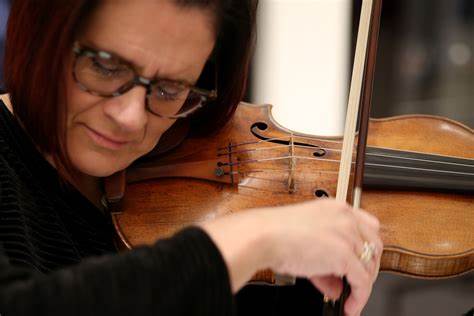
The Strad... What is it and Why is it Valued By So Much?
Share
Not much has changed in the field of violin production and dealing since Antonio Stradivari set up shop in Cremona, Italy, during the late 17th century. Dukes and queens coveted the craftsman’s creations back then; today, the instruments sell for wild sums to a comparable group of wealthy amateurs.
Of the 1,100 violins that Stradivari is believed to have made during his lifetime, only 650 are known to remain. Although there were other noted violin makers in Stradivari’s timesuch as Guarneri and Amati, whose works now fetch great sums of moneythe surviving Strads are more numerous, more famous and more expensive.
Even the most successful and celebrated luthier of all time might have been surprised to learn that his “Lady Tennant” violin was sold last year byChristie’s for more than $2.03 million, the highest amount ever paid for a musical instrument at a public auction.
In 1998, Christie’s auctioned a very similar Strad (crafted in 1698, one
In private, they may go for even more: The Stradivari Society, a private Chicago-based organization that purchases rare violins and loans them to promising young musicians, values some “golden era” (post-1700) Stradivari violins at $6 million each.
Stradivari (born 1644, died 1737) is believed by many to have built his finest instruments as an older and consequently more skilled craftsman. An early-period (pre-1700) Stradivarius, therefore, may sell for less. However, “such examples represent excellent values for musicians, as sound does not precisely follow price,” write Stradivari Society founders Robert Bein and Geoffrey Fushi in their essay, “The Masterpieces of Antonio Stradivari and Giuseppe Guarneri del Gesù: A Market Perspective.”
According to the Stradivari Society, the value of Stradivari and Guarneri violins has tripled since 1990.
“As institutions and museums hold an increasing percentage of the great violins, the competition intensifies for the remaining instruments when they do become available, and the continued increases in violin prices of the current decade dramatically reflect this fact,” say Bein and Fushi.
What gives this particular fiddle its unrivaled appeal? Some scientists have suggested that Stradivari used alpine spruce that had grown during an era of uncommonly cold weather. This may have made the wood abnormally dense and contributed to the brilliant sound quality of his instruments. Others insist that no instrument maker has ever worked harder.
Perhaps the answer lies closer to the fact that instrument connoisseurs, like stock investors, are drawn to a great story. Strads are undoubtedly beautiful in sound and design, and many have been passed down through the hands of generations of great musicians, from 18th-century master Nicolo Paganini to 20th-century virtuoso Yehudi Menuhin.
The allure of rich provenance may also explain how rock legends can turn cheaply-made guitars into million-dollar purchases. While violins still top the list of the most expensive instruments, their fretted cousins are quickly catching up, especially those attached to celebrity names.
“Musical instruments have been great investments, such that I now consider them to be far superior to
In fact, Gruhn suspects that Clapton’s “Blackie” guitarthe most expensive ever sold publicly, at $959,500 in 2004was assembled from guitar parts purchased in part from him in the 1970s for, oh, maybe a few hundred bucks. (Read Forbes FYI’s 2005 article on collecting rare guitars, “While My Guitar Gently Reaps.”)
Unlike
But is this kind of growth sustainable? “Only if one does [one's] due diligence,” cautions Christie’s Keane. He cites six fine-instrument value determinants:
1. Attribution (who made it)
2. Quality
3. Condition
4. Provenance (who played it)
5. Freshness to the market. An instrument brought out of 200 years in hiding incites “an air of discovery,” Keane says.
6. Fashion. For example, “classical guitars are hot right now.”
Once you’ve done your homework and put in your winning bid, don’t closet your new acquisition or display it on the mantle under your Picasso. Like wine or art, fine instruments need to be stored in a carefully monitored, semi-humid climate to maintain their worth.
As for the most expensive instrument ever sold”The Lady Tennant”it could fetch up to $3 million today in prime condition, Keane estimates.
Not a bad return for an old piece of wood.
